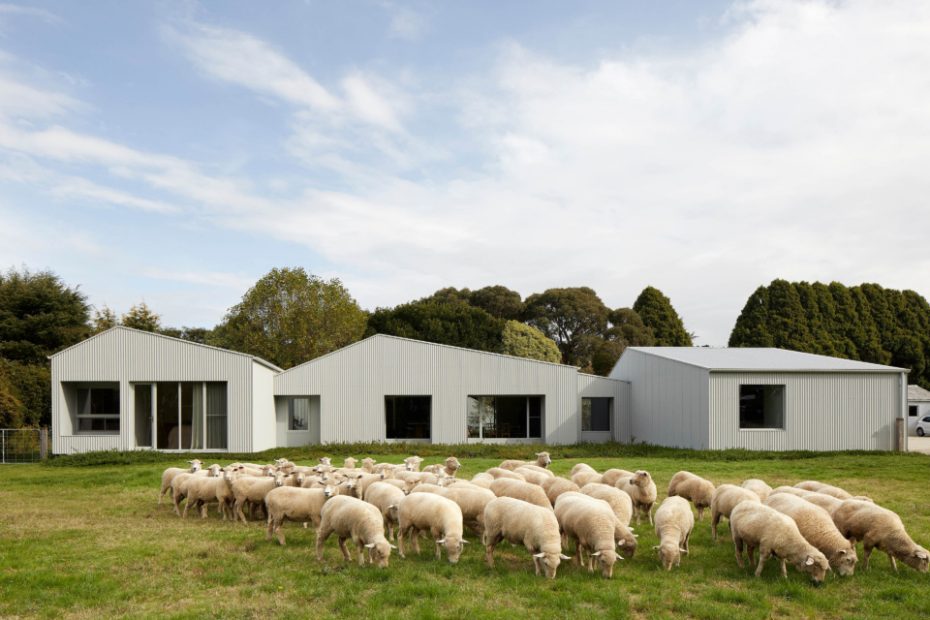An Impressive Modern Farmhouse Clad In Corrugated Iron
Architecture
Shady Creek Farmhouse by MRTN Architects is a new build in West Gippsland, Victoria.
The building is shaped around a central courtyard.
Singularly cladding sections of the walls and roof in corrugated iron was both cost-effective and considered of the property’s rural setting.
Crazy paving creates an inviting pathway around the house.
The ‘pinwheel plan’ of the build is centred around a concrete column with a scrabbled finish. Pendant light by Ross Gardam.
‘The glazed sliding door frames are recessed into this column so that they disappear when the doors are open,’ MRTN director Anthony says.
Timber brings warmth to the pared-back interiors. Rug by Jenny Jones.
Custom shelves by Darcy James.
The outward spread of the floorplan is divided into dedicated wings.
Concrete floors enhance the rustic architecture.
The kitchen reveals mint green tiles and light-washed timber.
Timber lines the open doorway, framing a view of the kitchen from the home’s entry.
Rug by Jenny Jones.
The main bedroom includes an ensuite and walk-in wardrobe.
The windows were strategically placed to capture the calming space of the garden, and not the working landscapes.
The corrugated iron exterior features simple cut openings to create a singular look of the cladding.
The house from the outside.
Not all farmhouses look like romantic country homes with wrap-around verandahs and gardens that we might picture in our cottagecore dreams.
In fact, MRTN Architects director Antony Martin says most are ‘pretty utilitarian spaces’ that have to accommodate working and living on a rural property.
‘Working farmers are often house proud, but then also tend to reinvest in their farms rather than their houses. A new shed will usually take precedence over new kitchen cabinets,’ Anthony says.
This was the backstory behind the practice’s recent farmhouse project in Shady Creek, about 100km southeast of Melbourne, near Warragul.
Surrounded by agricultural land, the existing 1950s building had barely been updated since it was built. It’s been the owner’s residence for the past seven years and the site of their business, farming sheep with the help of four German Shepard dogs in tow.
‘Our client wanted a home that honoured the origins of the farm. Having grown up around farms and being deeply respectful of those who have worked the land for years, she wanted the new home to be in the same location as the old, to not be too showy or mismatched to the farm outbuildings that were to remain,’ Anthony says.
‘Previously all the buildings around the service yard were light corrugated iron structures, with the exception of the house itself.’
They took direct inspiration from the assemblage of outbuildings to create a house where the roofs and walls are clad primarily in a light grey corrugated iron — a decision that was both cost-effective and considerate of the home’s rural backdrop.
Varying roof pitches add architectural flair, while also mirroring the slightly ‘odd’ mixed silohettes of the surrounding sheds.
The new build reveals a ‘pinwheel plan’, clustering shed-like structures around an open garden courtyard with a centrally placed concrete column inside.
‘Planning the house in this way, we were able to place an equal weighting to the three key living spaces; kitchen, living and dining; with what we consider an equal fourth living spaces which is the enclosed courtyard garden,’ Anthony says.
‘They all share a physical and visual connection to each other without one being the dominant space.’
Inside, the house is surprisingly cosy, anchored by timber joinery in every space. Polished concrete floors provide thermal mass alongside expansive glazing, helping limit the need for the highly efficient electric cooling and heating.
Windows capture views out to the foothills and fields beyond, while screening off the service and stock yards. Anthony says this has given the owner a sense of separation between the spaces for working and for living, allowing them to really enjoy the beauty of their newfound sanctuary.
